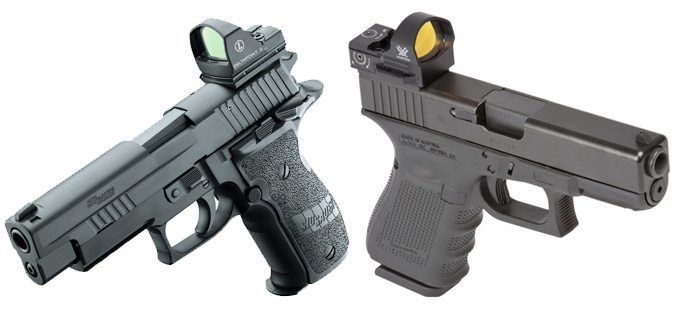Leupold Deltapoint and Vortex Razor – A closer look
Magnified optics might be the preferred choice for many but one cannot deny that red dot sights have quite a number of advantages and a resulting significant market of their own. Though full-size red dot sights might not hold out much longer, miniature red dot sights will most certainly stand the test of time. As in other superior quality optics, mini red dots do have a heavy price tag but the performance and durability factors more than compensate for that. Any red dot sight that has a size equivalent to that of Aimpoint Micro or smaller can be categorized as miniature red dots and many in this group are tubeless. These mini red dot sights can be utilized as both chief and additional sighting systems depending on the engagement range. Small circular bright red dots work well in case of smaller range of engagement due to the accuracy factor but for rifles with larger engagement ranges, mini red dots might not always be the first choice.
Among the many mini red dot sights available currently in the market, two come with a couple of innovative and interesting characteristics that are worth analyzing.
Leupold Deltapoint and Vortex Razor – A focus
Leupold Deltapoint and Vortex Razor are new entrants to the Red Dot sight market and are debut attempts of the respective companies in this area. Though there has not been much of a buzz on the two, both sights come equipped with a set of interesting characteristics that are hard to overlook. While the Deltapoint has a unique triangular reticle, the Razor comes with a handy pull-out battery tray.
- Size: The Vortex Razor at 1.4oz (2.5 with mount) is quite a bit heavier than the Deltapoint which is at 0.63oz.
- Lens: Though there might not be any difference in terms of performance or dependability, the Deltapoint does offer a bigger lens than the Razor.
- Image and Reticle color: There appears to be a significant difference in the color of images when viewed through both the screens. Images through the Razor have a blue and green hue while the Deltapoint offers a more neutral blend of colours. The difference could be attributed to the color of the reticle. The Deltapoint has an orange tinged reticle while the Razor is equipped with a bright red one.
- MOA, Dot Size: The Razor is available in multiple dot size versions, namely 3 and 6 MOA while the Deltapoint has a huge triangle (7.5 MOA) and a dot (3.5 MOA). The Razor dot is quite handy and works comfortably well for a few hundred yards at least. Upon proper examination one might be inclined to go for the Deltapoint triangle as it has a much larger surface to use for rapid aiming at closer distances, though the effectiveness depends entirely on the shooter’s preference.
- Reticle Illumination: The Deltapoint is equipped with auto illumination adjusters that regulate the level of illumination in accordance with the surrounding brightness. Covering the reticle brings down the surrounding brightness level to zero which then serves as an “off” option for the sight. The Razor comes with manual regulation options with 2 buttons for adjusting the level of brightness of which one can also be used as an on and off switch.
- Illumination regulation: Unlike the Aimpoint where the regulation of illumination is rapid and simple, the Razor adjustment buttons which are placed behind the lens hinder adjustment to an extent as the shooter’s fingers might block clear view. Though the large triangle aimpoint aids in acquisition, auto regulation of illumination in Deltapoint does have its share of issues. The adjustments depend on surrounding brightness and that might not always work well for quick target acquisition, especially in dark surroundings.
- Battery Life: The battery life of Deltapoint depends entirely on its usage and it has an auto-turn off option in case of nil movement detection. The fact that the sight has to be detached completely from its base using external tools to replace the battery might be a problem for many. Razor is also equipped with an auto turn of option but needs to be manually turned on when needed to be used again. At maximum setting, battery life of Razor sight is said to be about a year which is reasonably good for a mini red dot. Replacing the battery is an effortless affair in the Razor with its pull out battery tray.
- Performance: There is not much difference between the Deltapoint and Razor with respect to precision and accuracy but Deltapoint scores a bit higher in terms of design, build and convenience. Though the Razor has the advantages of bulk and handy battery tray, the bigger screen, triangular reticle and auto-control options of Deltapoint make it a better choice. If you are looking for a primary sight, Razor could be a better option while Deltapoint is a much better secondary sight option.
Specifications
|
Leupold Deltapoint |
Vortex Razor |
| It is 1.62” in length, 1.1” in height (1.4 with mount) and 1.22” in width with a weight of 0.63 oz. | It is 1.83” in length, 1.16” in height and 1.21” in width with a weight of 1.4 oz(2.5 oz with mount) |
| MOA: 7.5 MOA triangle and 3.5 MOA dot | MOA:3 MOA and 6 MOA |
| Battery: CR2032 and depends on the usage. Replacement needs to be done after detachment. | Battery: CR2032 with 1 year at the maximum setting. Replacement via pull-out battery tray. |
| Brightness: Auto adjustment in accordance with surrounding lighting | Brightness: Manual regulation with buttons. |
| Cost: $400 | Cost: $480 |
